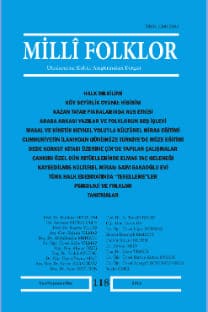Aşkın iki yüzü tek hali: Aşık Garip hikayesi ile Romeo ve Juliet'in mukayesesi
Bu makale, biri Türk halk edebiyatının, diğeri ise İngiliz edebiyatının klâsik eserlerinden olan Âşık Garip Hikâyesi ile Romeo ve Juliet arasındaki müşterekliklerin tespit ve tahliline yönelik mukayeseli bir çalışmadır. Eserler arasında mukayese yapılırken, olay örgüleri, figüratif yapıları ve motifleri esas alınmıştır. Yapılan mukayese neticesinde iki eserin vak’a örgülerinde (sonuç bölümü hariç) ve yukarıda zikredilen mukayese unsurları arasında birçok müştereklik bulunduğu tespit edilmiştir. Bu ortak unsurlar, iki eserden birinin diğerinden ilham yoluyla yazılmış olabileceği izlenimini uyandırmakla birlikte çalışmanın amacı bu durumu ispat etmek değildir. Aksine, makalenin yöntemi ve üslubunu edebî yaratmanın, müşterek konuları farklı zaman, kültür ve coğrafyalarda da olsa, ortak akılla benzer şekilde işleyebileceği görüşü belirlemiştir. Her iki eserde vak’anın başlangıç noktası olan aşk için kadın ve erkeğin yaptığı fedakârlıklar olayların seyrini belirler. Aynı zamanda toplumun, farklılıklara rağmen ortaya çıkan ‘aşk’ı algılayış biçimleri de temanın özünü oluşturur. Esasında mitik dönemlerden bugüne kadar evrensel bir duygu olan aşkın işlenişinde bazı ortaklıkların olması da doğaldır.
A comparison between the Tale of Asik Garip and Romeo and Juliet
This article is a study to compare and point out the similarities between The Tale of Asik Garip, a classic of Turkish folk literature, and Romeo and Juliet, a classical work of English literature. When the comparison between the works are done, story line technique, their motives and figurative structures have been evaluated. It has been concluded that there are many similarities between the works that are mentioned based on the comparison of the storyline of the works (excluding the conclusion parts) and the items mentioned above. These common features may open a way to feel that these two works are written with inspiration from the other. Neverthless, the aim of this study is not the justification of this situation. On the contrary, the style and the methodology of this study indicate that common content can be studied in common wisdom with similar ways in the creation of literature even in different cultures and geographies. In both works, the sacrificies of men and women determine the case of love that is the statrting point of the course of events. At the same time, the way of the perception of ‘love’ of the society that emerges despite differences compose the essence of the content. In fact, it is natural to observe some similarities in the study of love that has been a universal feeling from the mythic stages untill today.
___
- Aytaç, Gürsel, (2003), Karşılaştırmalı Edebiyat Bilimi, İstanbul.
- Eagleton, Terry (1998), William Shakespeare, Boğaziçi Üniversitesi Yay., İstanbul.
- Enginün, İnci (1992), Mukayeseli Edebiyat, Dergah Yay., İstanbul.
- Enginün, İnci (2008), Türkçede Shakespeare, Dergah Yay., İstanbul.
- Hibbard, G.R., (1973), Titus Andronicus and Romeo and Juliet, Shakespeare Select Bibliographical (Edited by Stanley Wells), Oxford University Press, London.
- Kefeli, Emel, (2000), Karşılaştırmalı Edebiyat İncelemeleri, İstanbul.
- Nutku, Özdemir, (2002), Romeo ve Juliet, Remzi Kitabevi, Ankara.
- Rado, Şevket, (1965), Kerem ile Hamlet, Hayat Tarih Mecmuası, S.9.
- Rousseau, A.M., Cl.Pichois, (1994), Karşılaştırmalı Edebiyat (Çev. Mehmet Yazgan), İstanbul.
- Shakespeare, W. (1998), Romeo ve Juliet (Çev. Yusuf Mardin), İstanbul.
- Tieghem, Paul Van, (1943), Mukayeseli Edebiyat (Çev. Yusuf Şerif Kılıçel), Ankara.
- Türkmen, Fikret (1995), Âşık Garip Hikâyesi İnceleme-Metin, Ankara.
- Wells, Stanley (1992), Shakespeare Yazar ve Eserleri (Çev. Cevza Sevgen), İstanbul.
